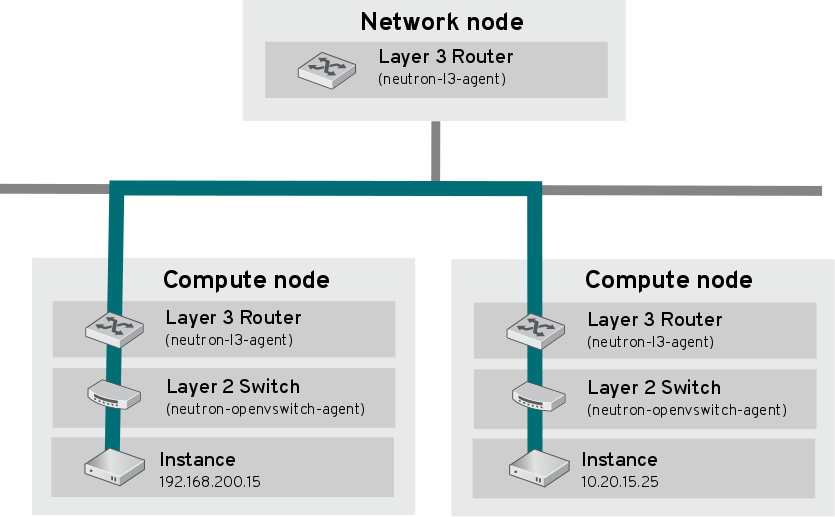Este contenido no está disponible en el idioma seleccionado.
Chapter 15. Configure Distributed Virtual Routing (DVR)
Distributed Virtual Routing (DVR) allows you to place L3 Routers directly on Compute nodes. As a result, instance traffic is directed between the Compute nodes (East-West) without first requiring routing through a Network node. In addition, the Floating IP namespace is replicated between all participating Compute nodes, meaning that instances with assigned floating IPs can send traffic externally (North-South) without routing through the network node. Instances without floating IP addresses still route SNAT traffic through the Networking node.
Red Hat OpenStack Platform 7 (kilo) added support for interconnecting between VLAN and VXLAN/GRE when using distributed routers. This integration allows connectivity between VLANs and VXLAN/GRE tunnels in DVR.
DVR is included as a technology preview in Red Hat OpenStack Platform 8. For more information on the support scope for features marked as technology previews, refer to https://access.redhat.com/support/offerings/techpreview/
In the diagram below, the instances on separate subnets are able to communicate, without routing through the Network node first:
15.1. Configure DVR
1. On the Network node, enable router_distributed in the neutron.conf file. This setting ensures that all routers created in future are distributed by default.
router_distributed = True
router_distributed = True
You can override the default behavior by editing the policy.json file:
neutron router-create --distributed=True/False <name>
neutron router-create --distributed=True/False <name>2. Configure the Layer 3 agent
On the Compute nodes, enable DVR in the l3_agent.ini file:
agent_mode = dvr
agent_mode = dvr
On the Network node, configure dvr_snat on the distributed router:
agent_mode = dvr_snat
agent_mode = dvr_snat3. Configure the Layer 2 agent
On the Network node and Compute nodes, enable DVR and L2 population on the L2 Agent. For example, if using Open vSwitch, edit the ovs_neutron_plugin.ini file:
enable_distributed_routing = True l2_population = True
enable_distributed_routing = True
l2_population = True4. Enable the L2 population mechanism driver in ML2
On the Controller, edit ml2_conf.ini:
[ml2] mechanism_drivers = openvswitch, l2population #Other values may be listed here as well
[ml2]
mechanism_drivers = openvswitch, l2population #Other values may be listed here as well
On the Compute nodes, edit ml2_conf.ini:
[agent] l2_population = True
[agent]
l2_population = True5. Restart the services for the changes to take effect:
On the Controller, restart the following services:
systemctl restart neutron-server.service systemctl restart neutron-l3-agent.service systemctl restart neutron-openvswitch-agent.service
# systemctl restart neutron-server.service
# systemctl restart neutron-l3-agent.service
# systemctl restart neutron-openvswitch-agent.serviceOn the Compute node, restart the following services:
systemctl restart neutron-l3-agent.service systemctl restart neutron-metadata-agent
# systemctl restart neutron-l3-agent.service
# systemctl restart neutron-metadata-agentIt is not currently possible to convert an existing non-distributed router to DVR. The router should instead be deleted and re-created as DVR.
